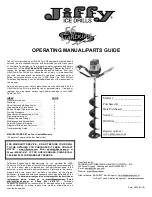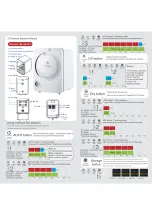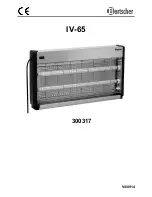
19
APP-001f
SEPT 2016
OPERATION
After the 10 minute STARTUP DELAY MODE is complete,
the purger will enter its normal mode of COLLECTING
AIR/WATER.
The foul gas that flows into the purger may carry a certain
amount of condensed refrigerant, which is captured by
the liquid drainer before it enters the purger’s condenser
coil. From the liquid drainer, the liquid is fed directly into
the low-pressure liquid return line. If this separation does
not occur, liquid refrigerant will fill the purger’s condenser
and limit the condensing capacity of the purger.
The liquid-free foul gas enters the purger condensing
coil, which is submerged in the flooded evaporator. The
refrigerant condenses inside the coil. The condensed
refrigerant and noncondensible gas then flow through
a check valve and into the air separator chamber. The
condensed liquid refrigerant is removed from the high-
pressure air separator chamber through the liquid metering
valve and to the low-pressure liquid return line.
Meanwhile, the noncondensible gas travels along the
top of the air separator chamber and into the float ball
chamber where it collects. As more noncondensible gases
collect, the liquid level gradually falls, causing the float
ball to fall. This changes the SPDT switch position of
the liquid level float switch and energizes the purge gas
solenoid valve (C) and the water bubbler fill line solenoid
valve (D), allowing noncondensible gas to bleed through
the orifice plate into the water bubbler. The Touchscreen
indicates RELEASING AIR. As air is released into the
water bubbler, the liquid refrigerant level in the purger
float ball chamber rises.
The control software operates each enabled remote
purge point solenoid valve in sequence. The control
software energizes each purge point for 10 minutes. If
noncondensibles are released during this 10 minute period,
then the control software will remain on that particular
purge point for 10 additional minutes, for a total of 20
minutes. If noncondensibles are released during this
second 10 minute period, then the control software will
remain on that particular purge point for another 10 minutes,
for a total of 30 minutes. After a total of 30 minutes on one
particular purge point, the control software will move to the
next purge point, regardless of whether noncondensibles
were released in the third 10 minute period.
The make-up liquid from the low-pressure pumped
liquid line typically contains a small percentage of water
dissolved in the liquid ammonia. This is the water the AUTO-
PURGER Plus will remove from the refrigeration system.
Liquid ammonia and water are brought into the evaporator
chamber of the purger, where the ammonia is evaporated
and the water remains. Gradually the concentration of water
in the evaporator chamber increases with time. When the
concentration of water in the evaporator chamber reaches
about 25% water for 10 continuous minutes, as detected
by the water concentration sensor, the AUTO-PURGER
Plus switches to the CONCENTRATING WATER mode. The
purger stops collecting air, isolates the mixture of water
and ammonia, and energizes the two electric heaters.
SECTION 4 AUTO-PURGER PLUS OPERATION
The AUTO-PURGER Plus is designed to automatically
startup and operate without the assistance of plant
personnel. Beginning at start-up, the following is a
description of the refrigerant flow through a purger when
all connecting shut-off valves are open, see Figure 6.
START-UP
Make sure all piping, electrical connections, and settings
are complete as described in this bulletin.
Models APPT08, APPT16, and APPT24 should have unused
purge points disabled before start-up. For example, an
APPT08 that will only use 6 of the possible 8 purge points,
should have purge points 7 and 8 disabled in the purger
software. All purge points are enabled when shipped
from the factory. To disable purge point, first energize the
purger. Press the ‘Purge Point Enable’ button on Menu
Screen 1. Then, touch the button of the purge point on the
screen you wish to disable. If purge point is not shown
on the screen, scroll up or down with \/ or /\ button to
get to the purge point to disable and touch that button
on the screen.
To start-up the APPT, open the foul gas, low-pressure
pumped-liquid, low-pressure liquid return, and suction
line shut-off valves. Open the purge gas valve. The water
purge line shut-off valve should remain closed at this
time (open only while draining water), see Figure 6. On
start-up, the AUTO-PURGER Plus enters a cooling down
stage. The display indicates 3333 EVAP TEMP >40F (4C).
In this stage, liquid refrigerant fills and cools the purger.
The low-pressure pumped-liquid line solenoid valve (B)
energizes to feed refrigerant to the low-pressure flooded
evaporator. The liquid make-up level sensor, located in the
evaporator chamber, senses when the flooded evaporator
is full and closes the low-pressure pumped-liquid line
solenoid valve (B).
At the same time the flooded evaporator is cooling, the
control software energizes the first purge point solenoid
valve. Foul gas enters the high-pressure air separator
chamber and condenses to fill the high-pressure air
separator chamber with liquid ammonia. When the float
switch chamber fills with liquid refrigerant, the float ball
rises and pulls in the float switch magnet. (If this chamber
is already full of air, the float switch magnet will not pull-in
until later when this air is released to the bubbler.)
After the evaporator shell temperature has cooled below
40°F, the purger switches from the cooling down stage to
STARTUP DELAY MODE for 10 minutes, as indicated by the
Touchscreen no longer displaying 3333 EVAP TEMP>40F
(4C), but instead displaying STARTUP DELAY MODE. The
control software will not allow any noncondensibles to
be released into the water bubbler until the 10 minute
STARTUP DELAY MODE is complete. This 10 minute delay
is necessary to give the purger time to condense enough
foul gas to fill the high pressure air separator chamber
with liquid ammonia.
continued on page 21
TROUBLESHOOTING GUIDE
On the touchscreen of the APPT there is a built-in troubleshoo>ng guide. This guide will show all the error messages
displayed, what the error condi>on is, and a few condi>ons to check to fix the error state. This guide can be
accessed in two ways, Menu Screen 3 has an op>on for Troubleshoo>ng Help. Pressing this op>on will bring you to
the menu below where you can select which error condi>on you are looking for.
O
O
The second way to access this guide is when you are in an error state there will be a buPon which will appear.
Pressing that buPon which coincides with the error state the APPT currently is in will bring up the troubleshoo>ng
sec>on for that par>cular error.
The guide programmed into the touchscreen is the same guide which is following this sec>on in the product
bulle>n.










































